Contemporary Cultural Trade of Lion Body Parts
Abstract
Simple Summary
Abstract
1. Introduction
2. Materials and Methods
2.1. Ethics Statement
2.2. Study Area
2.3. Study System
2.4. Survey Instrument
2.5. Limitations
2.6. Data Analyses
3. Results
3.1. Significance and Symbolism
3.2. Requests, Preferences and ‘Demand’
3.3. Trade
3.4. Source
3.5. Supply
3.6. Sustainability
4. Discussion
4.1. Research Ethic
4.2. Significance and Symbolism
4.3. Requests, Preferences and ‘Demand’
4.4. Trade
4.5. Source
4.6. Supply
4.7. Sustainability
5. Conclusions
Supplementary Materials
Author Contributions
Funding
Institutional Review Board Statement
Informed Consent Statement
Data Availability Statement
Acknowledgments
Conflicts of Interest
References
- Bauer, H.; Chapron, G.; Nowell, K.; Henschel, P.; Funston, P.; Hunter, L.T.B.; Macdonald, D.W.; Packer, C. Lion (Panthera leo) populations are declining rapidly across Africa, except in intensively managed areas. Proc. Natl. Acad. Sci. USA 2015, 112, 14894–14899. [Google Scholar] [CrossRef] [PubMed]
- Bauer, H.; Packer, C.; Funston, P.; Henschel, P.; Nowell, K. Panthera leo. Available online: https://www.iucnredlist.org/en (accessed on 14 September 2022).
- Becker, M.S.; Almeida, J.; Begg, C.; Bertola, L.; Breitenmoser, C.; Breitenmoser, U.; Coals, P.; Funston, P.; Gaylard, A.; Groom, R.; et al. Guidelines for evaluating the conservation value of African lion (Panthera leo) translocations. Front. Conserv. Sci. 2022, 3, 963961. [Google Scholar] [CrossRef]
- Coals, P.; Dickman, A.; Hunt, J.; Grau, A.; Mandisodza-Chikerema, R.; Ikanda, D.; Macdonald, D.W.; Loveridge, A. Commercially-driven lion part removal: What is the evidence from mortality records? Glob. Ecol. Conserv. 2020, 24, e01327. [Google Scholar] [CrossRef]
- Williams, V.L.; Loveridge, A.J.; Newton, D.J.; Macdonald, D.W. Questionnaire survey of the pan-African trade in lion body parts. PLoS ONE 2017, 12, e0187060. [Google Scholar] [CrossRef] [PubMed]
- Riggio, J.; Jacobson, A.; Dollar, L.; Bauer, H.; Becker, M.; Dickman, A.; Funston, P.; Groom, R.; Henschel, P.; de Iongh, H.; et al. The size of savannah Africa: A lion’s (Panthera leo) view. Biodivers. Conserv. 2013, 22, 17–35. [Google Scholar] [CrossRef]
- Williams, V.L.; Coals, P.G.; de Bruyn, M.; Naude, V.N.; Dalton, D.L.; Kotzé, A. Monitoring compliance of CITES lion bone exports from South Africa. PLoS ONE 2021, 16, e0249306. [Google Scholar] [CrossRef]
- Williams, V.L.; Loveridge, A.J.; Newton, D.J.; Macdonald, D.W. A roaring trade? The legal trade in Panthera leo bones from Africa to East-Southeast Asia. PLoS ONE 2017, 12, e0185996. [Google Scholar] [CrossRef]
- Lindsey, P.; Balme, G.; Midlane, N.; Alexander, R.; Craig, J. Possible relationships between the South African captive-bred lion hunting industry and the hunting and conservation of lions elsewhere in Africa: Research article. S. Afr. J. Wildl. Res. 2012, 42, 11–22. [Google Scholar] [CrossRef][Green Version]
- Williams, V.L.; Drouilly, M.; Dunnink, J.A.; Lishandu, M.; Whittington-Jones, G. Continuity in the cultural use of carnivores across. Presented at the Conservation Symposium, Scottburgh, KwaZulu-Natal, South Africa, 4 November 2022. Available online: https://www.youtube.com/c/ConservationSymposium/videos (accessed on 14 September 2022).
- Turner, J.; Wels, H. Lion conservation and the lion bone trade in South Africa: On CITES, Shifting Paradigms, “Sustainable Use” and Rehabilitation. Orient. Anthropol. 2020, 20, 303–314. [Google Scholar] [CrossRef]
- Arias, M.; Coals, P.G.; Ardiantiono; Powell, J.; Bell Rizzolo, J.; Ghoddousi, A.; Boron, V.; Da Silva, M.; Naude, V.N.; Poudel, S.; et al. Guarding against simplistic conceptions of illegal trade in big cats. Conserv. Sci. Pract. 2022; in review. [Google Scholar]
- Naude, V.N.; Balme, G.A.; Rogan, M.S.; Needham, M.D.; Whittington-Jones, G.; Dickerson, T.; Mabaso, X.; Nattrass, N.; Bishop, J.M.; Hunter, L.; et al. Longitudinal assessment of illegal leopard skin use in ceremonial regalia and acceptance of faux alternatives among followers of the Shembe Church, South Africa. Conserv. Sci. Pract. 2020, 2, e289. [Google Scholar] [CrossRef]
- Bauer, H.; Nowell, K.; Sillero-Zubiri, C.; Macdonald, D.W. Lions in the modern arena of CITES. Conserv. Lett. 2018, 11, e12444. [Google Scholar] [CrossRef]
- Green, J.; Hankinson, P.; de Waal, L.; Coulthard, E.; Norrey, J.; Megson, D.; D’Cruze, N. Wildlife trade for belief-based use: Insights from traditional healers in South Africa. Front. Ecol. Evol. 2022, 10, 906398. [Google Scholar] [CrossRef]
- Williams, V.L.; Newton, D.J.; Loveridge, A.J.; Macdonald, D.W. Bones of Contention: An Assessment of the South African Trade in African Lion Panthera leo Bones and other Body Parts; TRAFFIC: Cambridge, UK; WildCRU: Oxford, UK, 2015; Available online: https://www.traffic.org/publications/reports/bones-of-contention-south-african-trade-in-african-lion-bones-and-other-body-parts/ (accessed on 14 September 2022).
- Adeola, M.O. Importance of wild animals and their parts in the culture, religious festivals, and traditional medicine, of Nigeria. Environ. Conserv. 1992, 19, 125–134. [Google Scholar] [CrossRef]
- Plug, I. An analysis of witchdoctor divining sets. Res. NATCO Mus. 1987, 1, 47–67. [Google Scholar]
- Janzen, J.M. Ngoma: Discourses of Healing in Central and Southern Africa; University of California Press: Berkeley, CA, USA, 1992. [Google Scholar]
- Val, A.; Porraz, G.; Texier, P.-J.; Fisher, J.W.; Parkington, J. Human exploitation of nocturnal felines at Diepkloof Rock Shelter provides further evidence for symbolic behaviours during the Middle Stone Age. Sci. Rep. 2020, 10, 6424. [Google Scholar] [CrossRef] [PubMed]
- Williams, V.L.; Whiting, M.J. A picture of health? Animal use and the Faraday traditional medicine market, South Africa. J. Ethnopharmacol. 2016, 179, 265–273. [Google Scholar] [CrossRef]
- Simelane, T.S.; Kerley, G.I.H. Conservation implications of the use of vertebrates by Xhosa traditional healers in South Africa. S. Afr. J. Wildl. Res. 1998, 28, 121–126. [Google Scholar] [CrossRef]
- Thornton, R. The transmission of knowledge in South African traditional healing. Afr. J. Int. Afr. Inst. 2009, 79, 17–34. [Google Scholar] [CrossRef]
- Mokgobi, M.G. Understanding traditional African healing. Afr. J. Phys. Health Educ. Recreat. Danc. 2014, 20, 24–34. [Google Scholar] [CrossRef]
- Miller, S.M.; Harper, C.K.; Bloomer, P.; Hofmeyr, J.; Funston, P.J. Fenced and fragmented: Conservation value of managed metapopulations. PLoS ONE 2015, 10, e0144605. [Google Scholar] [CrossRef]
- Miller, S.M.; Riggio, J.; Funston, P.J.; Power, J.R.J.; Williams, V.L.; Matthew., F.C.; South African National Biodiversity Institute and Endangered Wildlife Trust. A conservation assessment of Panthera leo. In The Red List of Mammals of South Africa, Swaziland and Lesotho; South African National Biodiversity Institute and Endangered Wildlife Trust: Midrand, South Africa, 2016. [Google Scholar]
- Coals, P.; Burnham, D.; Loveridge, A.; Macdonald, D.W.; ’t Sas-Rolfes, M.; Williams, V.L.; Vucetich, J.A. The ethics of human–animal relationships and public discourse: A case study of lions bred for their bones. Animals 2019, 9, 52. [Google Scholar] [CrossRef]
- Coals, P.; Burnham, D.; Johnson, P.J.; Loveridge, A.; Macdonald, D.W.; Williams, V.L.; Vucetich, J.A. Deep uncertainty, public reason, the conservation of biodiversity and the regulation of markets for lion skeletons. Sustainability 2019, 11, 5085. [Google Scholar] [CrossRef]
- IUCN World Conservation Congress. Combatting the Illegal Trade in Lion Body Parts and Derivatives; IUCN World Conservation Congress: Gland, Switzerland, 2020; Available online: https://www.iucncongress2020.org/motion/072/57715 (accessed on 14 September 2022).
- Chilisa, B. Indigenous Research Methodologies; Sage Publications: New York, NY, USA, 2019. [Google Scholar]
- Mbongwa, N.S. The Perceptions, Attitudes and Knowledge of Traditional Healers and Traders about Using Cultivated Plants in South Africa. Master’s Dissertation, University of the Witwatersrand, Johannesburg, South Africa, 2018. [Google Scholar]
- McKean, S.; Mander, M.; Diederichs, N.; Ntuli, L.; Mavundla, K.; Williams, V.; Wakelin, J. The impact of traditional use on vultures in South Africa. Vulture News 2013, 65, 15–36. [Google Scholar] [CrossRef]
- Green, E.C.; Makhubu, L. Traditional healers in Swaziland: Toward improved cooperation between the traditional and modern health sectors. Soc. Sci. Med. 1984, 18, 1071–1079. [Google Scholar] [CrossRef]
- Freeman, M.; Motsei, M. Planning health care in South Africa--is there a role for traditional healers? Soc. Sci. Med. 1992, 34, 1183–1190. [Google Scholar] [CrossRef]
- Ensink, K.; Robertson, B. Patient and family experiences of psychiatric services and African indigenous healers. Transcult. Psychiatry 1999, 36, 23–43. [Google Scholar] [CrossRef]
- Cook, C.T. Sangomas: Problem or solution for South Africa’s health care system. J. Natl. Med. Assoc. 2009, 101, 261–265. [Google Scholar] [CrossRef]
- Mlisa, L.S. Ukuthwasa, Initiation of Amagqirha: Identity Construction and Training of Xhosa Women as Traditional Healers. Ph.D. Thesis, University of Free State, Bloemfontein, South Africa, 2009. [Google Scholar]
- Gumede, M.V. Traditional Healers: A Medical Doctor’s Perspective; Skotaville Publishers: Cape Town, South Africa, 1990. [Google Scholar]
- Nigosan, S.A. World Faiths; Martin’s Press: New York, NY, USA, 1994. [Google Scholar]
- Van Dyk, A.C. Traditional African beliefs and customs: Implications for AIDS education and prevention in Africa. S. Afr. J. Psychol. 2001, 31, 60–66. [Google Scholar] [CrossRef]
- Mokgethi, L.E. Defining Ukuthwasa as a Pedagogy: An Autoethnographic Exploration into the Knowledge Acquisition Process of Ukuthwasa at a Training School (lefehlo) in Soweto, Johannesburg. Master’s Dissertation, University of the Witwatersrand, Johannesburg, South Africa, 2018. [Google Scholar]
- Van der Walt, B.J. Understanding and Rebuilding Africa: From Desperation Today towards Expectation for Tomorrow; Institute for Contemporary Christianity in Africa: Potchefstroom, South Africa, 2003. [Google Scholar]
- Muzondi, N. The Contribution of Traditional Belief Systems in Biodiversity Conservation among the Ndau People in the Nyagadza Community of Chipenge. Master’s Dissertation, Midlands States University, Gweru, Zimbabwe, 2014. [Google Scholar]
- Hammond-Tooke, W.D. Rituals and Medicines: Indigenous Healing in South Africa; Ad. Donker: Johannesburg, South Africa, 1989. [Google Scholar]
- Berg, A. Ancestor reverence and mental health in South Africa. Transcult. Psychiatry 2003, 40, 194–207. [Google Scholar] [CrossRef]
- Thobane, M.S. Armed robbers: Creating a perception of invisibility and invincibility through mysticism—Are Sangomas providing protection? Acta Criminol. Afr. J. Criminol. Vict. 2015, 2015, 151–168. [Google Scholar] [CrossRef]
- Veenstra, S.J. Healing Ministry among the Zulu Speaking People Troubled by Evil Spirits. Master’s Dissertation, North-West University, Potchefstroom, South Africa, 2006. [Google Scholar]
- Washington, K. Zulu traditional healing, Afrikan worldview and the practice of Ubuntu: Deep thought for Afrikan/Black psychology. J. Pan Afr. Stud. 2010, 3, 24–39. Available online: http://jpanafrican.org/docs/vol3no8/3.8ZuluTraditional.pdf (accessed on 14 September 2022).
- Robertson, B.A. Does the evidence support collaboration between psychiatry and traditional healers? Findings from three South African studies: Review article. S. Afr. Psychiatry Rev. 2006, 9, 87–90. [Google Scholar] [CrossRef]
- Van Uhm, D.P.; Wong, R.W.Y. Establishing trust in the illegal wildlife trade in China. Asian J. Criminol. 2019, 14, 23–40. [Google Scholar] [CrossRef]
- Whiting, M.J.; Williams, V.L.; Hibbitts, T.J. Animals traded for traditional medicine at the Faraday market in South Africa: Species diversity and conservation implications. J. Zool. 2011, 284, 84–96. [Google Scholar] [CrossRef]
- Colwell, R. EstimateS: Statistical Estimation of Species Richness and Shared Species from Samples. Version 9.1. 2019. Available online: https://www.robertkcolwell.org/pages/estimates (accessed on 14 September 2022).
- Magurran, E. Measuring Biological Diversity; Blackwell Publishing: Oxford, UK, 2004; pp. 18–66. [Google Scholar]
- Konadu-Osei, O.A.; Boroş, S.; Bosch, A. Methodological decolonisation and local epistemologies in business ethics research. J. Bus Ethics 2022. [Google Scholar] [CrossRef]
- Rudd, L.F.; Allred, S.; Bright Ross, J.G.; Hare, D.; Nkomo, M.N.; Shanker, K.; Allen, T.; Biggs, D.; Dickman, A.; Dunaway, M.; et al. Overcoming racism in the twin spheres of conservation science and practice. Proc. R. Soc. B Biol. Sci. 2021, 288, 20211871. [Google Scholar] [CrossRef]
- Brittain, S.; Ibbett, H.; de Lange, E.; Dorward, L.; Hoyte, S.; Marino, A.; Milner-Gulland, E.J.; Newth, J.; Rakotonarivo, S.; Veríssimo, D.; et al. Ethical considerations when conservation research involves people. Conserv. Biol. 2020, 34, 925–933. [Google Scholar] [CrossRef]
- Vucetich, J.A.; Burnham, D.; Macdonald, E.A.; Bruskotter, J.T.; Marchini, S.; Zimmermann, A.; Macdonald, D.W. Just conservation: What is it and should we pursue it? Biol. Conserv. 2018, 221, 23–33. [Google Scholar] [CrossRef]
- Good, C.; Burnham, D.; Macdonald, D.W. A cultural conscience for conservation. Animals 2017, 7, 52. [Google Scholar] [CrossRef]
- Williams, V.L.; Burness, A.; Byrne, M.J. Medicinal plants sold by West, Central and East African immigrants in Johannesburg, South Africa. Trans. R. Soc. S. Afr. 2022, 77, 47–62. [Google Scholar] [CrossRef]
- Warchol, G.L.; Zupan, L.L.; Clack, W. Transnational criminality: An analysis of the illegal wildlife market in Southern Africa. Int. Crim. Justice Rev. 2003, 13, 1–27. [Google Scholar] [CrossRef]
- Everatt, K.T.; Kokes, R.; Lopez Pereira, C. Evidence of a further emerging threat to lion conservation; targeted poaching for body parts. Biodivers. Conserv. 2019, 28, 4099–4114. [Google Scholar] [CrossRef]
- Williams, V.L.; ‘t Sas-Rolfes, M.J. Born captive: A survey of the lion breeding, keeping and hunting industries in South Africa. PLoS ONE 2019, 14, e0217409. [Google Scholar] [CrossRef] [PubMed]
- Coals, P.; Moorhouse, T.P.; D’Cruze, N.C.; Macdonald, D.W.; Loveridge, A.J. Preferences for lion and tiger bone wines amongst the urban public in China and Vietnam. J. Nat. Conserv. 2020, 57, 125874. [Google Scholar] [CrossRef]
- Moorhouse, T.P.; Coals, P.G.R.; D’Cruze, N.C.; Macdonald, D.W. Reduce or redirect? Which social marketing interventions could influence demand for traditional medicines? Biol. Conserv. 2020, 242, 108391. [Google Scholar] [CrossRef]
- Burgess, G.; Olmedo, A.; Veríssimo, D.; Waterman, C. Changing consumer behavior for pangolin products. In Pangolins; Academic Press: Cambridge, MA, USA, 2020; pp. 349–366. [Google Scholar] [CrossRef]
- Cunningham, A.B.; Zondi, A.S. Use of Animal Parts for the Commercial Trade in Traditional Medicines, 1st ed.; Institute of Natural Resources: Pietermaritzburg, South Africa, 1991. [Google Scholar]
- Koopman, A. Zulu Plant Names; University of KwaZulu-Natal Press: Pietermaritzburg, South Africa, 2015. [Google Scholar]
- Otieno, J.; Abihudi, S.; Veldman, S.; Nahashon, M.; van Andel, T.; de Boer, H.J. Vernacular dominance in folk taxonomy: A case study of ethnospecies in medicinal plant trade in Tanzania. J. Ethnobiol. Ethnomed. 2015, 11, 10. [Google Scholar] [CrossRef]
- Williams, V.L.; Balkwill, K.; Witkowski, E.T.F. A lexicon of plants traded in the Witwatersrand umuthi shops, South Africa. Bothalia 2001, 31, 71–98. [Google Scholar] [CrossRef]
- Williams, V.L.; Moshoeu, T.J.; Alexander, G.J. Reptiles sold as traditional medicine in Xipamanine and Xiquelene Markets (Maputo, Mozambique). S. Afr. J. Sci. 2016, 112, 9. [Google Scholar] [CrossRef]
- Williamson, J.; Maurin, O.; Shiba, S.N.S.; van der Bank, H.; Pfab, M.; Pilusa, M.; Kabongo, R.M.; van der Bank, M. Exposing the illegal trade in cycad species (Cycadophyta: Encephalartos) at two traditional medicine markets in South Africa using DNA barcoding. Genome 2016, 59, 771–781. [Google Scholar] [CrossRef]
- Cousins, S.R.; Witkowski, E.T.F. African cycad ecology, ethnobotany and conservation: A synthesis. Bot. Rev. 2017, 83, 152–194. [Google Scholar] [CrossRef]
- Balding, M.; Williams, K.J.H. Plant blindness and the implications for plant conservation. Conserv. Biol. 2016, 30, 1192–1199. [Google Scholar] [CrossRef] [PubMed]
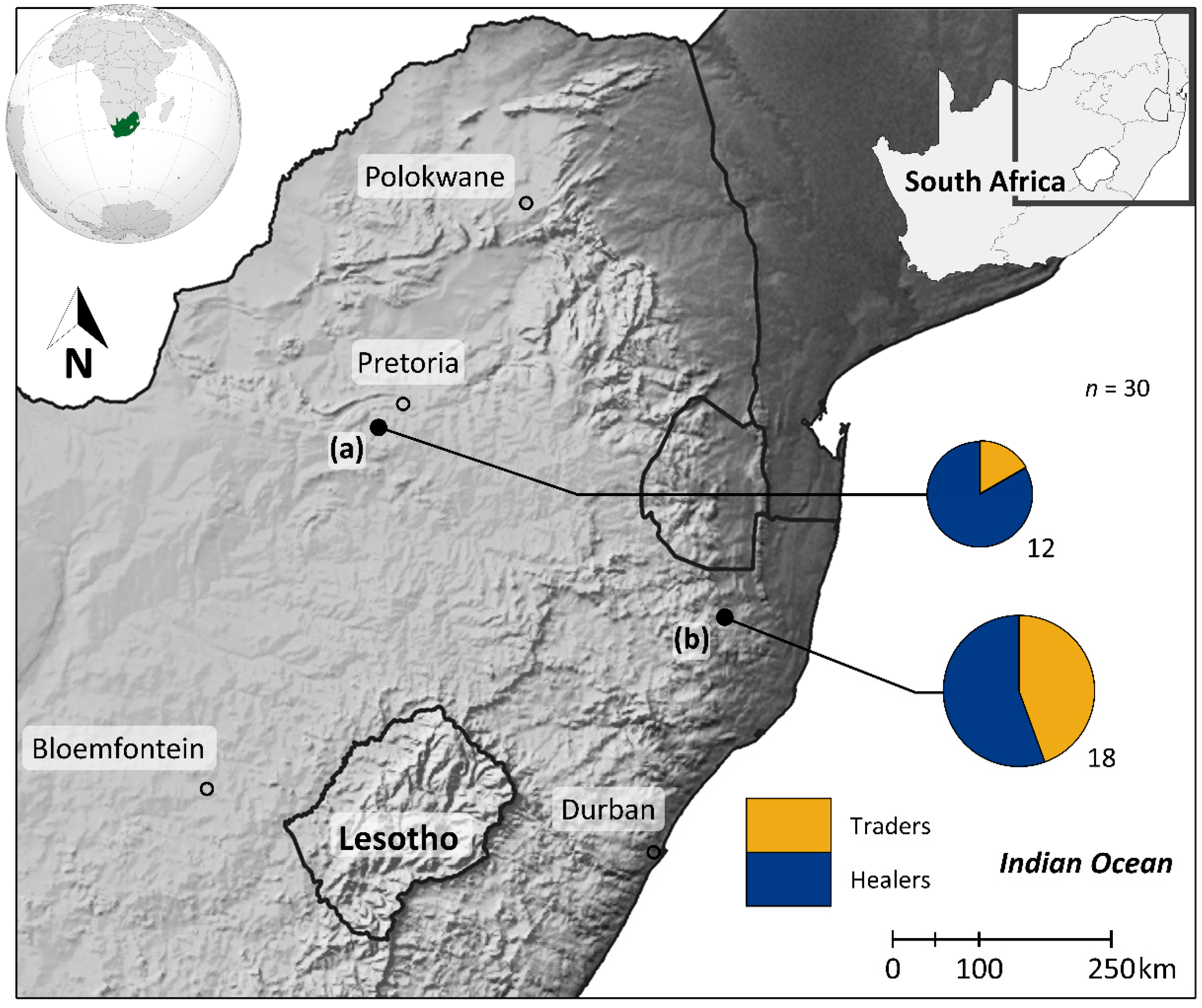


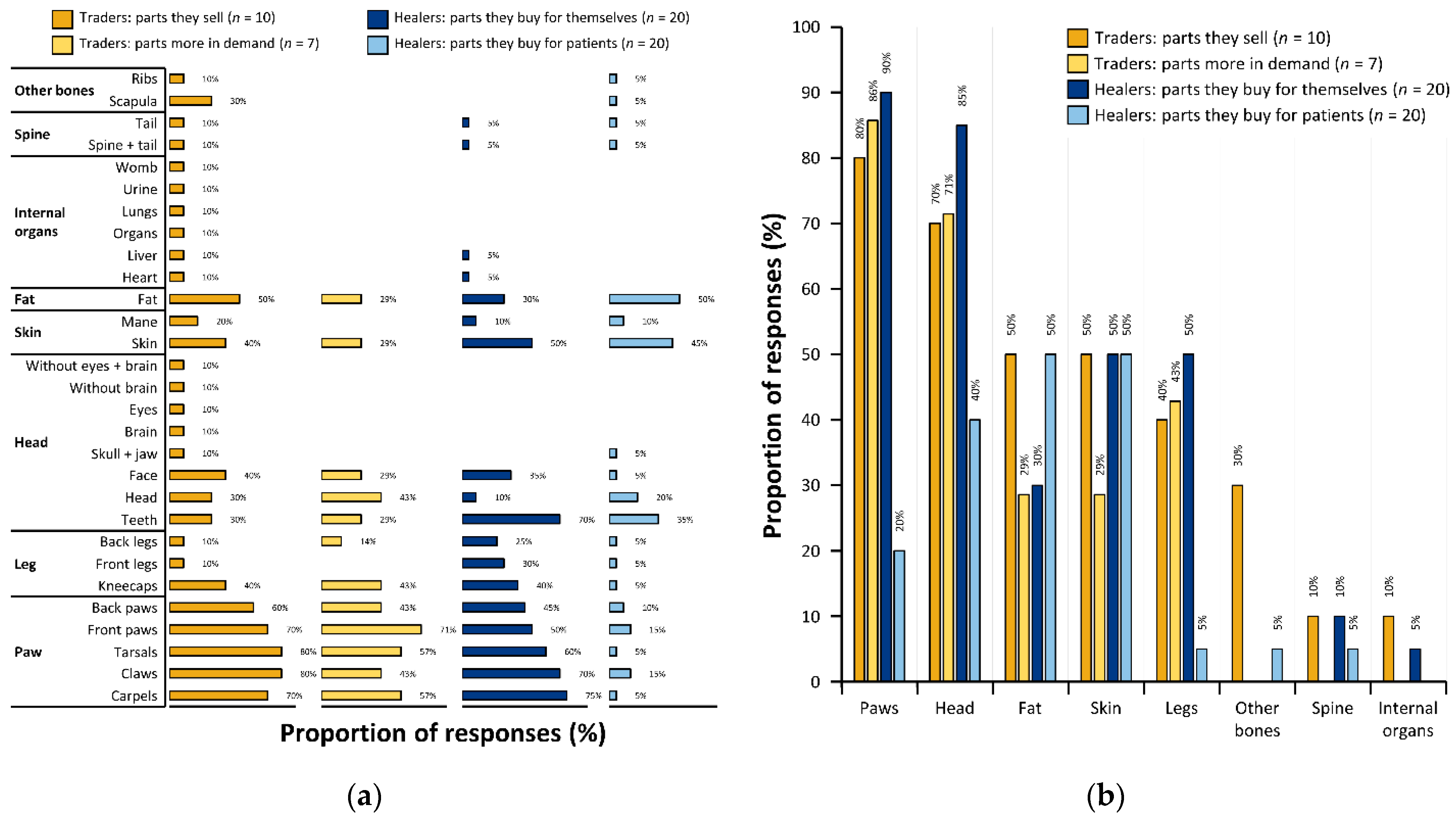
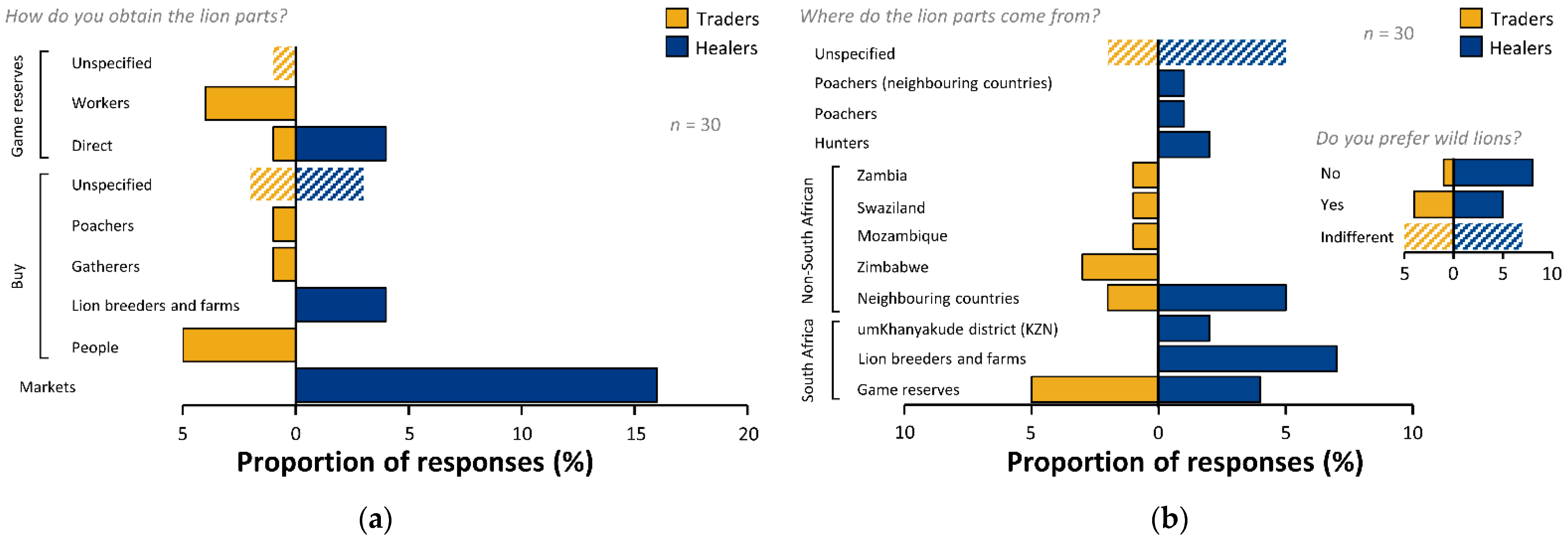
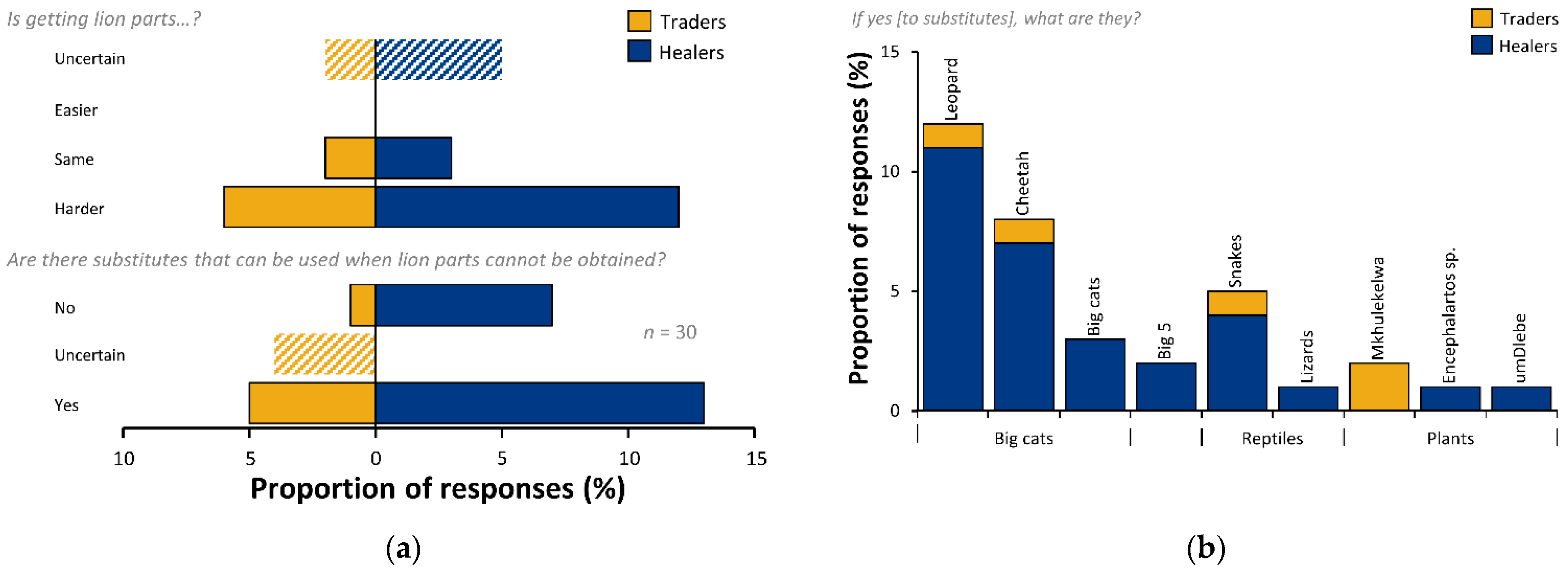

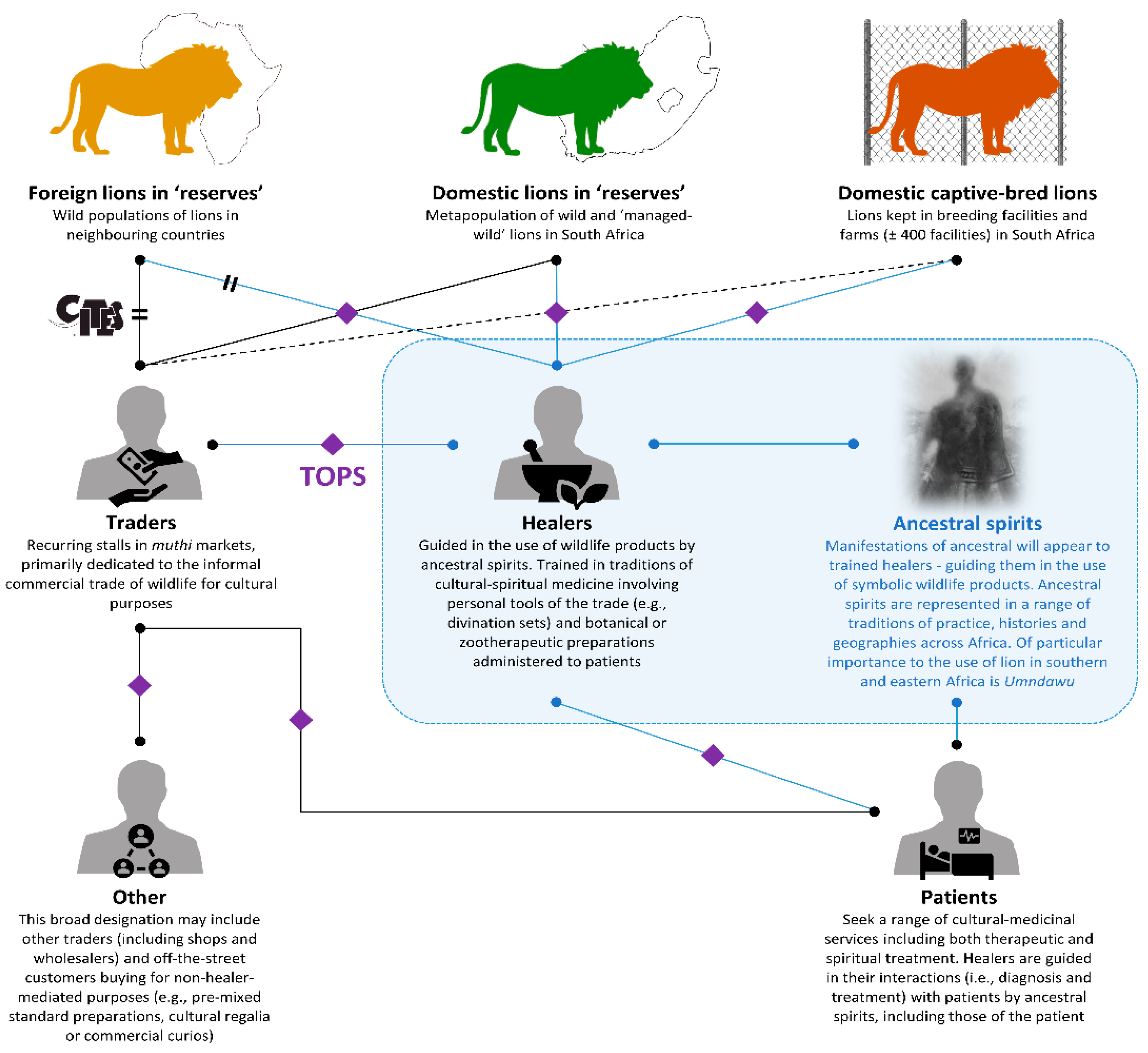
| (a) Similarity between Respondent Groups | (b) Similarity within Respondent Groups | ||||
|---|---|---|---|---|---|
| Traders (n = 10): Parts They Sell * | Traders (n = 7): Parts in Demand ** | Healers (n = 20): Parts for Themselves | Number of Parts Similar | % Parts Similar | |
| Traders (n = 10): parts they sell | 3.4 ± 2.9 | 40% ± 32% | |||
| Traders (n = 7): parts in demand | 12 (59%) | 1.8 ± 1.7 | 35% ± 30% | ||
| Healers (n = 20): parts for themselves * | 18 (77%) | 12 (80%) | 3.0 ± 1.9 | 46% ± 25% | |
| Healers (n = 11): parts for patients * | 19 (79%) | 12 (77%) | 16 (87%) | 2.1 ± 1.1 | 51% ± 30% |
Publisher’s Note: MDPI stays neutral with regard to jurisdictional claims in published maps and institutional affiliations. |
© 2022 by the authors. Licensee MDPI, Basel, Switzerland. This article is an open access article distributed under the terms and conditions of the Creative Commons Attribution (CC BY) license (https://creativecommons.org/licenses/by/4.0/).
Share and Cite
Coals, P.G.R.; Mbongwa, N.S.; Naude, V.N.; Williams, V.L. Contemporary Cultural Trade of Lion Body Parts. Animals 2022, 12, 3169. https://doi.org/10.3390/ani12223169
Coals PGR, Mbongwa NS, Naude VN, Williams VL. Contemporary Cultural Trade of Lion Body Parts. Animals. 2022; 12(22):3169. https://doi.org/10.3390/ani12223169
Chicago/Turabian StyleCoals, Peter G. R., Nolwazi S. Mbongwa, Vincent N. Naude, and Vivienne L. Williams. 2022. "Contemporary Cultural Trade of Lion Body Parts" Animals 12, no. 22: 3169. https://doi.org/10.3390/ani12223169
APA StyleCoals, P. G. R., Mbongwa, N. S., Naude, V. N., & Williams, V. L. (2022). Contemporary Cultural Trade of Lion Body Parts. Animals, 12(22), 3169. https://doi.org/10.3390/ani12223169






